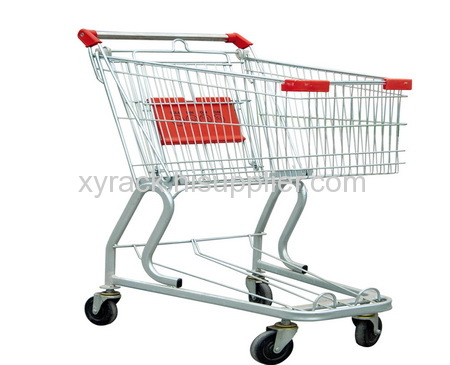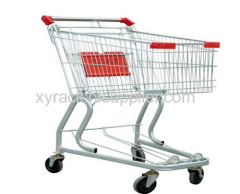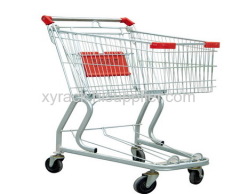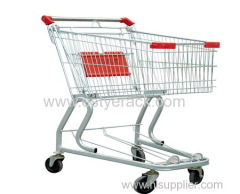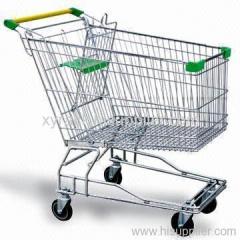
|
Weifang Estye Imp&Exp Co.,Ltd.
|
trolley
| Price: | 40.0~60.0 USD |
| Payment Terms: | T/T,L/C,WU |
| Place of Origin: | Shandong, China (Mainland) |
|
|
|
| Add to My Favorites | |
| HiSupplier Escrow |
Product Detail
1, German style shopping trolleys.
2, Various sizes are available.
3, Prompt delivery time.
4, Wonderful looks.
5, Convenient to transport.
Shopping trolley description:
Almost all shopping carts are made of metal or plastic and designed to nest within each other in a line to facilitate moving many at one time, and to save on storage space. The carts can come in many sizes, with larger ones able to carry a child. There are also specialized carts designed for two children, and electric mobility scooters with baskets designed for disabled customers. 24,000 children in the USA are injured each year in shopping carts. Some stores have child carts that look like a car or van with a seat where a child can sit. Such "Car-Carts" or "Beans", as some call them in the cart business, may offer protection and convenience by keeping the child restrained, lower to the ground, protected from falling items, and amused.
Shopping carts are usually fitted with four caster wheels which can point in any direction to allow maneuvering. However, when any one wheel jams, the cart can become difficult to handle. Many carts only have swivel caster wheels on the front, while the rear ones are on a fixed axle.

An alternative to the shopping cart is a small handheld shopping basket. A customer may prefer a basket for a small amount of merchandise. Small shops, where carts would be impractical, often supply only baskets. A collapsible utility cart has a basket pivotally mounted to a forward facing, C-shaped cart frame. As the lower portion of the C-shaped cart frame is moved under a flat bed (station wagon, etc), the upper part containing the basket slides onto the truck bed. The frame is then pivoted upward around the truck bumper and about the basket and conveniently stored around the basket. U.S. Patent 5,503,424 details this invention, which is marketed as Autocarts.

Shopping carts are usually fitted with four caster wheels which can point in any direction to allow maneuvering. However, when any one wheel jams, the cart can become difficult to handle. Many carts only have swivel caster wheels on the front, while the rear ones are on a fixed axle.

An alternative to the shopping cart is a small handheld shopping basket. A customer may prefer a basket for a small amount of merchandise. Small shops, where carts would be impractical, often supply only baskets. A collapsible utility cart has a basket pivotally mounted to a forward facing, C-shaped cart frame. As the lower portion of the C-shaped cart frame is moved under a flat bed (station wagon, etc), the upper part containing the basket slides onto the truck bed. The frame is then pivoted upward around the truck bumper and about the basket and conveniently stored around the basket. U.S. Patent 5,503,424 details this invention, which is marketed as Autocarts.

1) Name : Shopping cart
2) Contents: 60-240 Liter
3) Bearing : 90-150KG can load
4) Surface Treatment : Chrome plating. Galvanization or Powder Coated are available
5) Wheels : 4 Inch PVC 4Inch PU and 5Inch PU wheel
6) Different litres ,type ,treatment ,logo required are available for us
7) Installed with one dollar/Europe coin operated lock are choicable
8) Help to print your logo onto the handle for free
9)Color of plastic parts are choiceable
10)OEM service can be offered
11) Suitable for European, American and Japanese supermarket
2) Contents: 60-240 Liter
3) Bearing : 90-150KG can load
4) Surface Treatment : Chrome plating. Galvanization or Powder Coated are available
5) Wheels : 4 Inch PVC 4Inch PU and 5Inch PU wheel
6) Different litres ,type ,treatment ,logo required are available for us
7) Installed with one dollar/Europe coin operated lock are choicable
8) Help to print your logo onto the handle for free
9)Color of plastic parts are choiceable
10)OEM service can be offered
11) Suitable for European, American and Japanese supermarket
Didn't find what you're looking for?
Post Buying Lead or contact
HiSupplier Customer Service Center
for help!

